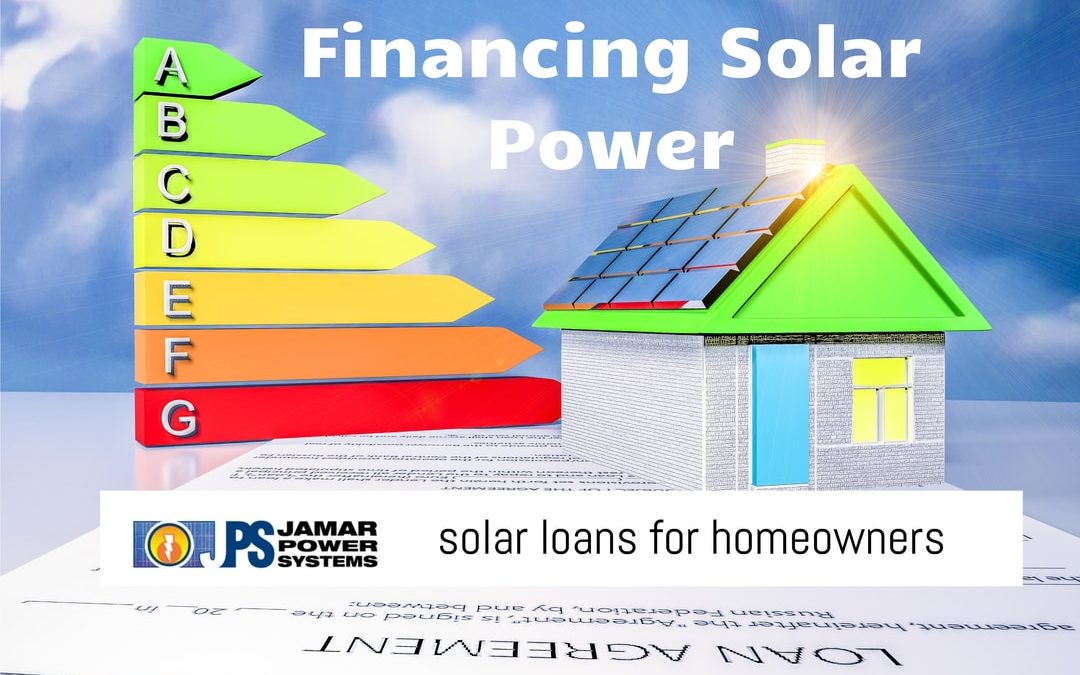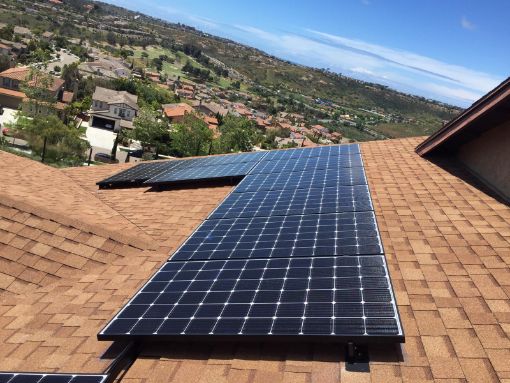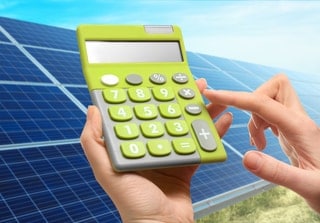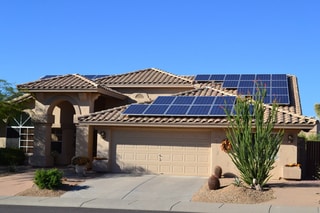Solar Loans | Solar Panel Financing
The great news for homeowners looking to take advantage of solar energy to power their homes and save money is that there are plenty of solar financing choices available, and most do not require any down payment.
Costs to produce solar electricity are so much less than utility electricity that in most cases, even with financing, homeowners can start saving money beginning the very first month their system turns on.
Savings of tens of thousands of dollars is common after 10 to 20 years.
Disclaimer: each home is different as is each family’s electricity needs. Solar equipment quality and efficiency varies widely. Savings are never guaranteed.
Solar panel financing for homeowners
The best path for most homeowners “going solar” to purchase it so that they own the solar power system.
Leases and power purchase agreements provided the first solar financing options for homeowners and created a boom in the industry.
But today, there’s an abundance of solar loans available for homeowners to own their system and reap all of the benefits of going solar.
Owning your solar power system allows for greater savings through the years and free electricity for years or decades once it’s paid off.
Quality solar panels and inverters have 25-year warranties, providing peace of mind to owners.
Owning the solar energy system allows for easier selling of real estate, as opposed to leases and power purchase agreements (PPA), which require real estate buyers to qualify separately for the lease/PPA, or to buy out the contract.
You need taxable income because you can be eligible for 30% of the price back in federal income tax credits from Uncle Sam after you file your taxes (system must be installed by 12/31/2032 to qualify).
If you can’t claim the federal income tax credit because your income is non-taxable income, then a lease or PPA might be a better choice.
There are many differences to consider when choosing whether to buy a solar energy system, lease it, or use a PPA. For a more in-depth discussion, see our FREE Guide to a Solar Lease, PPA, and Purchase.
Solar financing options
Cash
If you have the money, the return on investment (ROI) for a solar energy system is usually double-digits.
Payback periods are usually within 4 to 7 years, with free electricity for decades afterward.
Depending on your location and energy needs, solar power systems can provide high returns for a very low-risk investment that provides immediate energy savings.
See our article on “How many solar panels do I need?” for more info on that topic.
Cash is NO longer needed for solar!
If you don’t have the funds to purchase your system outright, have no fear, today there are many solar financing options available for you.
Zero-money down solar loans!
Most available solar loans have NO down-payment requirements. So you can start saving money in the first month!
Let’s explore several common solar panel financing choices.
Types of solar loans
Home equity loans
A home equity loan is one in which you borrow against your home’s equity. The equity of your home is the difference between what you owe on your mortgage and the total appraised value of the property.
Home equity loans usually have the best rates, and you can get them from banks and credit unions.
Home equity loans are often called home improvement loans, as the idea is to raise the value of the home with the renovations.
Home equity loans are secured loans, which means that you’ll be agreeing to use a property as collateral. Be sure you can afford to pay the loan back, so you don’t run the risk of losing your home.
Home equity loans are paid to you in one lump sum. You make monthly payments over time per the terms in the agreement.
One kind of home equity loan is a home equity line of credit or a HELOC. HELOCs are very similar in that they use your home’s equity for home improvement, and secure the agreement with your home as collateral.
The main difference is that HELOCs are not paid to you in a lump sum. Instead, they’re an approved line of credit from which you can withdraw funds up to your credit limit within a draw period.
The draw is usually done with a particular credit card or with checks, and it’s very similar to a credit card account. Some HELOCs will have you pay the loan back in full once the draw period has ended, while others will have you make regular payments throughout a repayment period.
Credit Unions
A loan from a credit union or a bank would be a personal loan. These loans can be used for anything, so they can also be applied to solar installation costs.
If you have something to offer as collateral and good credit, your Credit Union interest rates, and repayment terms may be very desirable.
Some lenders offer unsecured personal loans for the specific purpose of solar panel financing.
Unsecured personal loans usually come at a fixed-rate and are paid back in equal installments, and they come with much higher interest rates.
Solar loans
Solar loans are from direct lenders and are specifically for solar power systems for homeowners.
Usually, your local solar installation companies will provide options for you to finance your solar panels through their preferred solar lenders.
The collateral for these loans is the solar power system itself, which means the lender can repossess the system or place a lien on your property if you’re unable to pay them back.
Cities, counties, states, or utilities in some areas of the country may offer low-interest loans or solar rebates as incentives to go solar, so be sure to take a look at what your jurisdiction is offering. For more info for your area see https://www.dsireusa.org/
How does solar panel financing work?
Solar loans have two parts.
The first part is a loan in the amount of the expected federal tax credit you will receive next year. This way, you don’t have to come out-of-pocket for that amount up front and then wait a year to get it back.
This first part of a solar loan is due the following year after you do your taxes, file IRS form 5695 for the solar tax credit, and receive the tax credit check from Uncle Sam.
You can choose not to pay all or a portion of this tax credit amount back to the solar lender, the result would be that the balance of the remainder of the loan will be larger than planned, and therefore the loan will be re-amortized. A new, much higher monthly payment will be due.
The chart below is the updated Federal Investment Tax Credit (ITC) schedule for solar energy systems installed for your home or business.*
- 30% until 12-31-2032
- 26% in 2033
- 22% in 2034
- Zero afterwards
*updated after Congress extended the solar investment tax credit in August 2022.
The second part of a solar loan is for the balance cost of the system after the tax credit, which is the net cost of the solar power system.
Monthly payment terms for this loan amount can be for 5, 7, 10, 15, 20, 25, and even 30 years depending on the finance company.
Common solar loan companies are:
- Mosaic
- Enerbank
- Sungage Financial
- Green Sky Financial
We promote zero-down solar financing through Sungage Financial but you can shop and choose any lender that suits you.
Fannie Mae HomeStyle Loans
Fannie Mae HomeStyle Loans may also be an option for solar energy system installations.
The Federal National Mortgage Association, FNMA, or Fannie Mae is a government-sponsored enterprise established by Congress in 1938 in the middle of the Great Depression.
Fannie Mae’s purpose was to make mortgages more available to moderate-to low-income families and stimulate the housing market.
Fannie Mae Homestyle Energy loans are for making improvements to the comfort of the home by making energy or water efficiency upgrades.
You can apply for a Fannie Mae HomeStyle Energy Loan when purchasing a home or refinancing one. You can fund a clean-energy upgrade such as solar installation up to 15% of the home’s value.
PACE loans
Property assessed clean energy loans (PACE).
PACE loans are paid through your property taxes and provided by a partnership between a lender and your local county.
PACE loans are a public-private venture between your county tax accessor and a financial lender.
Payments for PACE loans are made through your property taxes.
These loans promote energy-saving upgrades and reduce electrical loads on local municipal utilities.
It’s also easy to qualify for PACE loans. You only need equity in your home. FICO scores and personal credit is not needed other than—usually—no bankruptcies in the last few years, and no late payments on mortgage or property taxes in the previous few years.
The cost of that easy qualifying for PACE loans is that they have higher interest rates than most other choices. But if you have no credit or poor credit, or if you’re selling the home soon while real estate is riding high, then a PACE loan might be perfect for you.
PACE loans are not available in every area, so look and see what’s available near you. Ask your County Tax Assessor and/or several solar dealers.
Interest on PACE loans is usually tax-deductible if you itemize (this is NOT tax advice, always consult a tax advisor).
A significant difference is that PACE loans transfer with the property. The loan is against the property, not the property owner.
When selling a property with a PACE loan, the loan amount stays on the property taxes and would transfer to the buyer.
PACE loans are liens, and they come into play when negotiating the sale price of the home. The difference is this debt starts on the buyer’s side.
Note: that PACE debt also represents a solar energy system that should be providing operating savings over similar homes in the neighborhood.
Ygrene Energy provides PACE loans in San Diego County.
Here’s a quick Q&A recap:
Can I finance solar panels?
Yes, many types of solar loans are available. Home equity, solar lender, Fannie Mae, and PACE loans are all available tools for financing solar energy systems.
How much is a solar loan?
Solar loans will have competitive interest rates based on credit.
Zero money down loans usually still provides for a total payment LESS than what you’re currently paying for electricity.
At the end of the loan term, all of the electricity the system produces will be free, rather than serving a lifetime payment sentence with your electric utility company.
How long is a solar loan?
Monthly payment terms can be for 5, 7, 10, 15, 20, 25, and even 30 years depending on the finance company.
What credit score is needed for solar panels?
A mid-600 or better FICO score is required for most home equity and solar loans.
There is NO personal credit score requirement for PACE loans because the loan is against your property taxes. Most require only sufficient home equity and no bankruptcies or late mortgage or tax payments in the last few years.
There are a variety of options available for homeowners who want to consider going solar. Speak to your Credit Union, bank, and solar advisor to decide what solar panel financing option is right for you.
Want to know what the numbers would look like for your home to go solar? Check out our FREE San Diego Solar Calculator! to find out how many solar panels your home’s needs, what the approximate cost would be, and an estimated monthly payment if financed.
- How Solar Batteries Work - March 4, 2024
- Solar Battery or Generator for Emergency Backup Power? - January 30, 2024
- How to Check If Your Solar Panels Are Charging The Solar Battery - January 12, 2024






